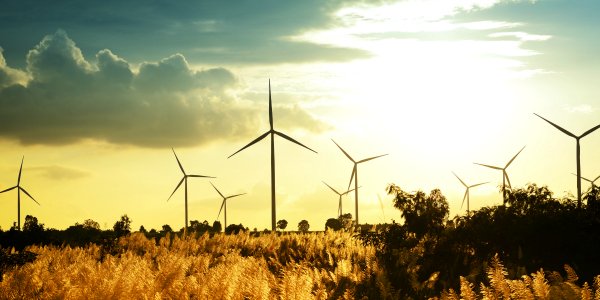
 |
Dr Jethro Browell 14 December 2018 |
The decarbonisation of electricity generation has been the major driver of wider decarbonisation in the UK over the past 15 years (See: Ofgem). Increasing the share of low-carbon electricity generation will continue to be an effective means of decarbonising over the next 15 years, but it brings with it some challenges in terms of managing the grid. Electricity networks need more than a supply of energy to function – they need a wide range of services to ensure that supply and demand match on a second-by-second basis, and to manage the flows of power around the network. A wide range of ancillary services play a vital role in keeping the lights on. These services regulate frequency and voltage under normal conditions, and also provide contingencies for faults and other risks.
If we want a truly low-carbon electricity system, we’ll need low-carbon ancillary services as well as low-carbon electricity. The good news is that renewables such as wind and solar can provide many of these services – and at highly competitive rates in many cases – but the market for these services needs to be updated to match the emerging needs of the electricity system and to allow renewables to compete on a level playing field with the fossil fuelled power plants which provide the majority of services today. The University of Strathclyde has been working with the energy industry to help make low-carbon ancillary services a reality.
What are ancillary services and who provides them now?
Just like other commodities, the electricity that is delivered to consumers is expected to meet certain standards of quality. In this case, that means a voltage of around 230V (or perhaps higher for industrial consumers), a frequency of 50Hz and with almost no interruptions in supply. Electrical devices may be damaged or even pose a safety risk if power quality drifts too far from these targets. Furthermore, generators - from large power stations to domestic solar - may disconnect themselves from the grid if the voltage or frequency become extreme, potentially causing further disruption.
To date, ancillary services have mainly been provided by conventional power plants, those with large synchronous generators that rotate at the grid frequency. In fact, these generators help maintain the grid frequency automatically by providing ‘inertia’: the sheer mass of their rotating generator slows down any change in grid frequency caused by a mis-match of supply and demand. They can also automatically change their output to rebalance supply and demand, thus providing a frequency response service. Similarly, this type of generator can also provide reactive power services by producing and absorbing reactive power, which regulates voltage.
It wasn’t long ago that these conventional generators provided almost all of our electricity too, but today a significant portion comes from wind and solar power. In 2017 wind and solar provided 18.7% of electricity on the GB grid, and as much as 47% during some half-hour periods (Data from National Grid and Elexon). During these periods of high renewable penetration, there is both a reduced pool of conventional plant able to provide ancillary services and an increased demand for those same services.
The increased demand is in part a consequence of wind and solar not having any inertia, meaning that the grid frequency can change more quickly and therefore more and faster frequency response is required. Another driver is the size of the largest unexpected generation unit outage that National Grid must prepare for, currently up to 1320MW, depending on the schedule of specific generators. With the completion of Hinkley Point C (1800MW) and planned new interconnectors to other countries this could increase significantly, and with it, so will demand for frequency response.
The need for fast frequency response in GB today is largely met by batteries, which have disrupted the market, reducing prices for some ancillary services by over 50% since 2016 (Data: National Grid). The role of batteries in future electricity systems is a hot topic in research as the technology continues to develop and reduce in cost. Their integration is also a challenge as they exhibit characteristics of both demand (when charging) and generation (when discharging), but also have limited storage capacity so can’t only generate (or consume) power continuously for extended periods of time.
Low-carbon ancillary services
While wind turbines and solar panels may not provide inertia, they connect to the grid via highly controllable electronics which convert the direct current electricity generated by the turbines and panels into the alternating current with a frequency of 50Hz to match the grid. This allows the power output of wind and solar farms to be changed very quickly to help keep the grid frequency at 50Hz and provide reactive power services. Using this technology, wind turbines can even emulate inertia by extracting kinetic energy from their rotating parts to briefly increase their electrical power output.
The best part is that the lack of fuel costs mean that this can all be done at extremely low cost. However, providing frequency response requires power from the wind or sun, which is variable and can only be accurately forecast a few days ahead. This is a problem in the current market, as the majority of ancillary services are procured a month or more in advance, meaning that wind and solar can’t join in. Furthermore, the economics of providing upward response aren’t appealing: the market value of supplied electrical energy is far greater than the value of frequency services, and leaving head-room to be able to increase output quickly in in response to a frequency drop would mean lost revenue from energy generation. This isn’t the case for wind turbines’ emulated inertia but there is no route to market for this capability in GB at present.
Near future of Ancillary Services in GB
The electricity landscape is changing rapidly and ancillary services is part of that change. A wide range of changes to the ancillary service market are being explored. Among the most exciting for renewables is the move to day-ahead procurement via an auction. From summer 2019 some frequency response products will be bought in a competitive auction only a day before they are required. On these time scales weather forecasts are accurate enough for wind and solar to compete with the likes of batteries, biomass, combined cycle gas and coal plants. New products are also being designed to combine the capabilities of multiple technologies, including emulated inertia, to provide super-fast frequency response in regions where it is most needed under the name Enhanced Frequency Control Capability (EFCC).
The University of Strathclyde has been working with the energy industry on collaborative initiatives such as EFCC and directly with wind farm operators on taking frequency response from wind turbines to market. EFCC is in advanced stages of testing and in the second half of 2018 wind farms have begun competing for provision of High Frequency Response and are being called upon to provide this service to the grid and applying price pressure on competitors. This is important work in developing our low carbon electricity system and contributing to building a reliable, cost-effective and low-carbon grid.
Tags: Energy